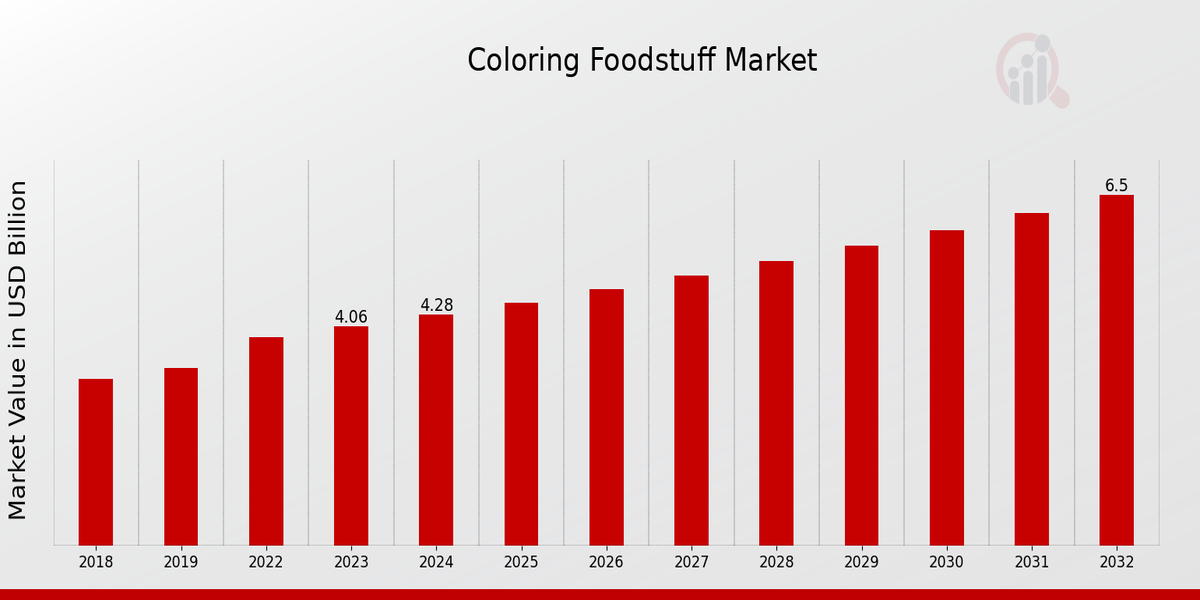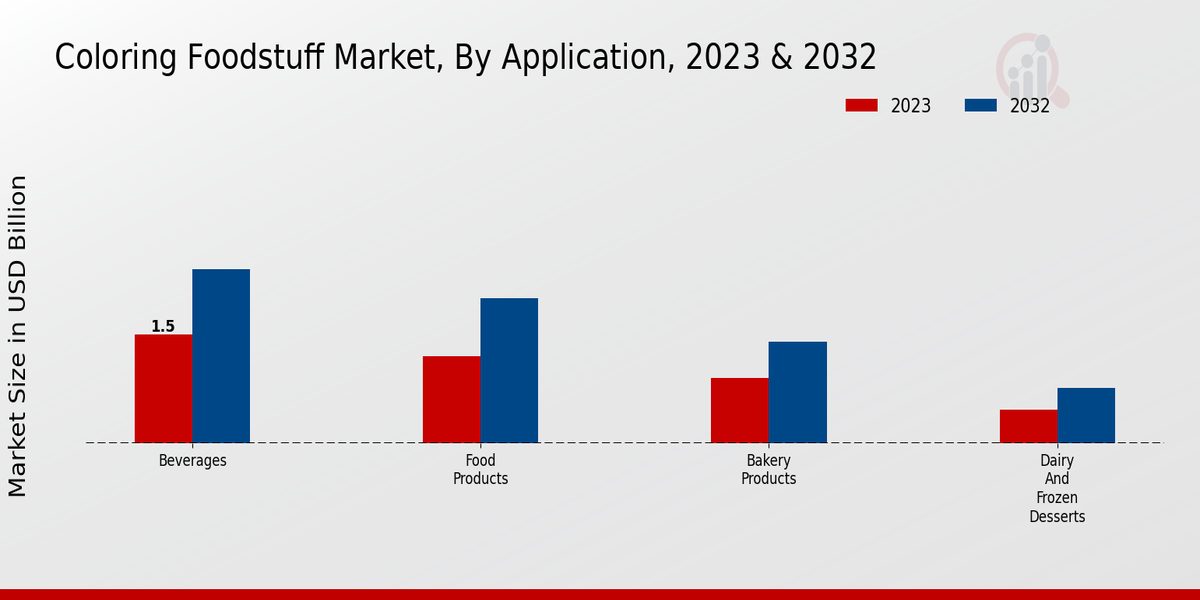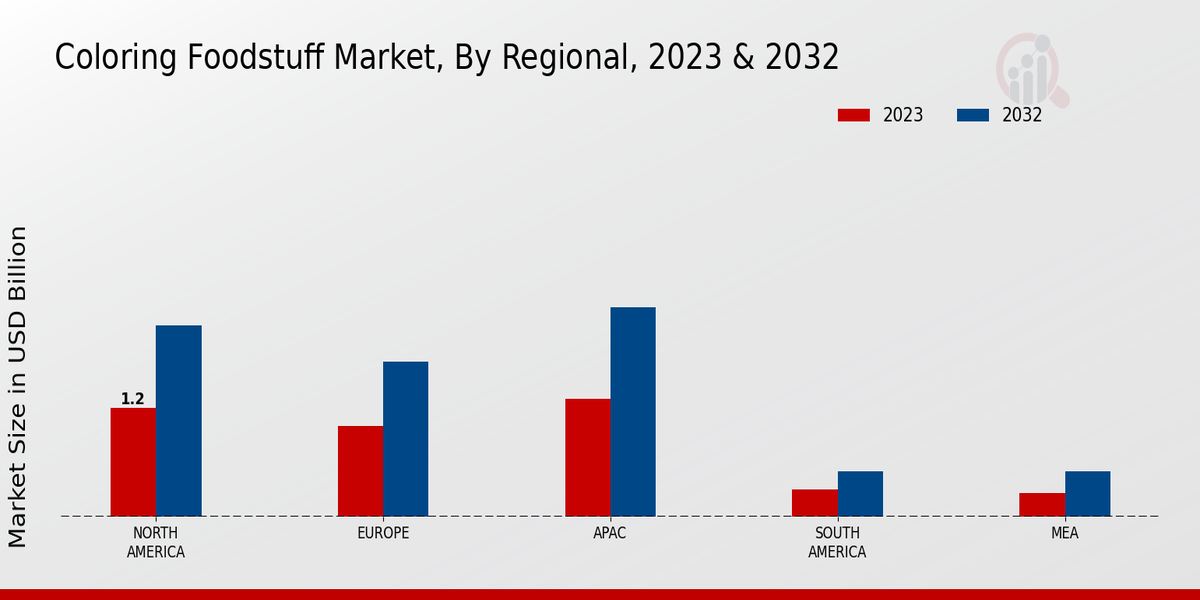Coloring Foodstuff Market Overview
Coloring Foodstuff Market Size was estimated at 3.86 (USD Billion) in 2022. The Coloring Foodstuff Market Industry is expected to grow from 4.06(USD Billion) in 2023 to 6.5 (USD Billion) by 2032. The Coloring Foodstuff Market CAGR (growth rate) is expected to be around 5.35% during the forecast period (2024 - 2032).
Key Coloring Foodstuff Market Trends Highlighted
The market for Coloring Foodstuff is booming because end-users are demanding for more natural and organic products. Due to increase in health consciousness, consumers now prefer using natural coloring agents than synthetic ones. Such change is also encouraged by food safety regulations and the awareness of the harmful effects caused by the use of artificial ingredients that compel producers to redesign product formulations incorporating natural color solutions. This change occurs together with the satisfying of the consumer preferences but also advances the general diet improvement trend. The prospects within the market are very many especially with more food and beverage manufacturers exploring expanding their offerings with new options.
Emerging markets can be targeted, highlighting the increased demand for processed food. New extraction technologies can facilitate the process of obtaining natural colors and making them simpler and less expensive. Also, with the growing clean labeling trend, those brands that have more transparent sourcing standards can gain greater competitiveness in the market. Recently, the market has been observing a growing trend of mass usage of Colouring Foodstuff for a number of applications including the confectionary and the Dairy sector. Such trends as the widespread introduction of new product variants with a bright, completely natural colour into the market increase competition and the attractiveness of the product to end customers – consumers
Moreover, the growing popularity of plant-based food has also driven interest in plant-based colorants. Not only do they complement the dietary trend, but they also support eco-friendly efforts. Revolution in customization of food products has charted the path for brands to use unique color palettes to appeal to the various consumer segments influencing how the eating foodstuff market is likely to move.
Source Primary Research, Secondary Research, MRFR Database and Analyst Review
Coloring Foodstuff Market Drivers
Increasing Demand for Natural Food Colorants
The growing consumer preference for natural and organic products is a significant driver in the Coloring Foodstuff Market Industry. As health consciousness rises, more consumers are moving away from synthetic food colorants due to their perceived negative health implications. This shift towards natural ingredients is being amplified by a broader trend of clean label products, where consumers seek transparency in ingredient sourcing and production processes.Food manufacturers are responding to this demand by innovating and expanding their product lines to include natural coloring agents derived from fruits, vegetables, and other plant-based sources. Not only are these natural colorants seen as safer alternatives, but they also enhance the nutritional profile of products, making them more appealing to health-oriented consumers. The emphasis on sustainability and environmentally friendly practices is also influencing this trend; natural colorants are often perceived as an eco-friendlier option compared to their synthetic counterparts.Furthermore, regulatory bodies are increasingly discouraging the use of artificial colors, prompting food manufacturers to invest in research and development of new, innovative natural colorants. This confluence of consumer preference, regulatory trends, and sustainability issues is shaping a robust market for natural food colorants, giving it a pivotal role in the future of the Coloring Foodstuff Market.
Growth in the Food and Beverage Industry
The expansion of the food and beverage sector has a direct correlation with the Coloring Foodstuff Market Industry. As the population increases and urbanization progresses, there is a heightened demand for diverse food products, including snacks, beverages, and processed foods. Innovative product launches aimed at capturing consumer attention often utilize vibrant colors to enhance visual appeal, thereby stimulating demand for various coloring foodstuffs.Moreover, the trend of food personalization and customization in restaurants and food service establishments further drives the need for visually appealing ingredient options, pushing manufacturers toward innovative coloring solutions.
Technological Advancements in Colorant Production
Technological advancements in the processing and extraction of coloring agents are propelling market growth within the Coloring Foodstuff Market Industry. Improved methods for obtaining pigments from natural sources not only boost quality but also enhance the efficiency of production processes. Innovations such as fermentation technology and biotechnology are leading to the development of new colorants that are more stable and cost-effective, making them attractive alternatives for food manufacturers.As these technologies evolve, they provide new opportunities for product differentiation and brand positioning in an increasingly competitive market.
Coloring Foodstuff Market Segment Insights
Coloring Foodstuff Market Application Insights
The Coloring Foodstuff Market segment focusing on Application is showing a notable valuation pattern as it encompasses several vital areas such as Beverages, Food Products, Bakery Products, and Dairy and Frozen Desserts. In 2023, the overall market valuation is projected to stand at 4.06 USD Billion, reflecting a steady growth trajectory that translates into a healthy influx of innovations and developments in coloring solutions across various applications. Notably, the Beverages application dominates this segment with an estimated valuation of 1.5 USD Billion in 2023, which is expected to grow significantly and reach a value of 2.4 USD Billion by 2032. This substantial market share underscores the critical role of visual appeal in beverage marketing and product differentiation, driving the demand for appealing color solutions that enhance consumer experienceMeanwhile, the Food Products application holds a significant portion, valued at 1.2 USD Billion in 2023. The growing consumer interest in aesthetics and the naturalness of food has fostered an environment where subtle yet appealing colors can influence purchasing decisions. Additionally, the Bakery Products segment, carrying a valuation of 0.9 USD Billion in 2023, plays a crucial role as well, given that colors in baked goods are not only about appearance but also impact perceived freshness and flavor, making it a vital consideration in product development. The Dairy and Frozen Desserts application, while smaller at 0.46 USD Billion in 2023, is increasingly recognized for its potential, showcasing growth opportunities as innovations in natural coloring agents meet consumer demands for healthier options. As the market continues to evolve, factors such as consumer health consciousness, preferences for natural colorings, and product innovation are driving competitive dynamics within the Coloring Foodstuff Market. Overall, each application contributes uniquely to market growth, with Beverages leading in dominance, while other applications gradually establish their relevance and importance in catering to the changing demands of consumers in a vibrant and competitive industry landscape.
Source Primary Research, Secondary Research, MRFR Database and Analyst Review
Coloring Foodstuff Market Type Insights
The Coloring Foodstuff Market, valued at 4.06 USD Billion in 2023, shows a notable diversification in its Type segment, which mainly includes Natural Coloring Agents and Artificial Coloring Agents. As consumer preferences shift towards healthier options, Natural Coloring Agents have gained prominence owing to their perceived benefits and clean-label appeal. This segment complements the increasing demand for organic and natural food products, thereby significantly influencing the overall market growth. Conversely, Artificial Coloring Agents continue to hold a substantial share, primarily due to their cost-effective nature and ability to provide vibrant, consistent coloration in processed foods.The unique features of both types present diverse opportunities for manufacturers, driving innovation and tailored solutions within the Coloring Foodstuff Market industry. The trends indicate a balanced competition, where Natural and Artificial Coloring Agents cater to varying consumer needs, contributing to the overall market statistics and revenue potential. Furthermore, the ongoing research and development efforts aimed at enhancing the safety and acceptance of these agents reflect the dynamic nature of the market, showcasing significant advancements and challenges alike.
Coloring Foodstuff Market Source Insights
The Coloring Foodstuff Market, valued at 4.06 billion USD in 2023, showcases a diverse segmentation based on Source, which includes Plant-based, Animal-based, and Mineral-based coloring agents. The market is witnessing significant growth, with an expected increase to 6.5 billion USD by 2032. Plant-based colorants hold a prominent position due to their natural appeal and rising consumer preference for clean-label products, driving much of the demand in the industry. Meanwhile, Animal-based colorings serve niche applications and cater to specific culinary traditions, although they face scrutiny concerning animal welfare.Mineral-based colorants, often regarded for their stability and safety, attract a segment of the market focused on regulatory compliance and functionality. As health consciousness and sustainability trends shape consumer choices, the Coloring Foodstuff Market is poised to benefit from the growing inclination toward natural and safe food additives. The emphasis on health and environmental sustainability underpins key market growth drivers and presents opportunities for innovation and product development, ensuring that these sources remain significant in the overall market landscape.
Coloring Foodstuff Market End Use Insights
The Coloring Foodstuff Market is projected to grow significantly, influenced by its various end-use applications, including the Food Industry, Beverage Industry, Pharmaceuticals, and Cosmetics. In 2023, the market was valued at 4.06 billion USD, reflecting robust demand in these sectors. The Food Industry remains a significant driver, utilizing coloring agents to enhance attractiveness and appeal of products. The Beverage Industry, with a growing emphasis on natural colors, plays a pivotal role in market dynamics as consumers increasingly prefer visually appealing and naturally sourced options.Pharmaceuticals employ coloring foodstuffs for product differentiation and to aid in patient compliance, while the Cosmetics sector, garnering notable attention, relies on such colors for aesthetic enhancement and branding. The diverse applications of coloring foodstuffs across these industries underscore their essential role in product formulation, consumer attraction, and overall market growth. As per Coloring Foodstuff Market statistics, the anticipated expansion from 2024 to 2032 shows the increasing significance of each segment, driven by changing consumer preferences and regulatory trends towards safe and organic coloring options.
Coloring Foodstuff Market Regional Insights
The Coloring Foodstuff Market is expected to show significant growth across various regions, with North America leading the valuation at 1.2 USD Billion in 2023, projected to rise to 2.1 USD Billion by 2032, indicating a strong demand driven by diverse food applications and consumer preference shifts toward natural colors. Europe follows closely with a market value of 1.0 USD Billion in 2023, expected to grow to 1.7 USD Billion, where stringent food regulations and a growing inclination towards organic and clean-label products drive market dynamics.The APAC region, valued at 1.3 USD Billion in 2023 and projected to reach 2.3 USD Billion by 2032, stands out as a significant area due to its rapidly expanding food and beverage industry and increasing urbanization. South America represents a smaller yet emerging market with a valuation of 0.3 USD Billion in 2023, anticipated to increase to 0.5 USD Billion, mainly supported by rising health consciousness among consumers. The MEA region, valued at 0.26 USD Billion in 2023, shows potential growth to 0.5 USD Billion as economic developments enhance food processing capabilities.Each region presents unique opportunities and challenges, influencing the overall Coloring Foodstuff Market revenue and segmentation.

Source Primary Research, Secondary Research, MRFR Database and Analyst Review
Coloring Foodstuff Market Key Players and Competitive Insights
The Coloring Foodstuff Market is a dynamic and competitive landscape characterized by a diverse range of products and innovations aimed at enhancing the visual appeal of food items. This market has witnessed significant growth, driven by increasing consumer demand for naturally derived ingredients and a growing focus on clean label products. With a variety of players competing through diverse product lines and innovative solutions, the market showcases a blend of established firms alongside emerging players that continually seek to leverage new technological advancements and trends to capture greater market share. Companies are formulating strategies that include partnerships, acquisitions, and investments in research and development to ensure they stay ahead of the competition.ColorMaker has carved a significant niche in the Coloring Foodstuff Market by emphasizing its commitment to quality and innovation. The company’s strength lies in its wide range of coloring foodstuffs that cater to diverse consumer preferences, effectively meeting the rising demand for natural and safe products. ColorMaker's operational excellence enables it to maintain high standards in production while ensuring flexibility to adapt to changing market demands. This adaptability is further complemented by a robust distribution network that allows for efficient supply chain management and strong customer relationships. ColorMaker's emphasis on sustainability and environmentally friendly practices positions it as a forward-thinking player in the market, attracting health-conscious consumers who value transparency and quality.Muller and Knaus have established themselves as notable contributors to the Coloring Foodstuff Market through their commitment to delivering high-quality color solutions that enhance food aesthetics without compromising on safety or taste. One of the strengths of Muller and Knaus is their advanced research capabilities, which allow them to develop innovative products tailored to meet specific customer needs while responding effectively to market trends. Their robust portfolio of coloring agents, including both synthetic and natural options, caters to various applications across the food industry, making them a preferred choice for many manufacturers. Additionally, Muller and Knaus focus on building long-term partnerships with clients, enhancing their market presence and fostering customer loyalty, which is vital in a competitive landscape where consumer preferences are rapidly evolving.
Key Companies in the Coloring Foodstuff Market Include
- ColorMaker
- Mullerand Knaus
- ADM
- BASF
- FMC Corporation
- Tateand Lyle
- Palatinit
- Hansen
- Bell Flavors and Fragrances
- Fi Herbal
- Sensient Technologies
- Kerry Group
- Natural Colors
- Givaudan
Coloring Foodstuff Market Industry Developments
The Coloring Foodstuff Market has seen significant developments recently. Major companies such as ADM, BASF, and Kerry Group are expanding their portfolios and exploring new opportunities in natural coloring solutions, reflecting a growing trend towards clean label products. ColorMaker and Chr. Hansen are also focusing on innovative technologies to enhance product offerings, which are contributing to market growth. The demand for plant-based feeding solutions and natural colorants is on the rise, spurred by consumer preferences for healthier options. Notably, significant mergers and acquisitions are influencing the market landscape; for example, recent expansions and collaborations among companies like Givaudan and Sensient Technologies highlight strategic consolidations aimed at enhancing product diversity and regional reach. Furthermore, growth trajectories are evident, with market valuations of firms like Tate and Lyle showing positive trends that draw investor interest. This evolving landscape emphasizes the crucial role of sustainability and innovation in meeting consumer demands while shaping the future of the coloring foodstuff sector.
Coloring Foodstuff Market Application Outlook
- Beverages
- Food Products
- Bakery Products
- Dairy and Frozen Desserts
Coloring Foodstuff Market Type Outlook
- Natural Coloring Agents
- Artificial Coloring Agents
Coloring Foodstuff Market Source Outlook
- Plant-based
- Animal-based
- Mineral-based
Coloring Foodstuff Market End Use Outlook
- Food Industry
- Beverage Industry
- Pharmaceuticals
- Cosmetics
Coloring Foodstuff Market Regional Outlook
- North America
- Europe
- South America
- Asia Pacific
- Middle East and Africa
Coloring Foodstuff Market Report Scope
|
Report Attribute/Metric
|
Details
|
|
Market Size 2022
|
3.86(USD Billion)
|
|
Market Size 2023
|
4.06(USD Billion)
|
|
Market Size 2032
|
6.5(USD Billion)
|
|
Compound Annual Growth Rate (CAGR)
|
5.35% (2024 - 2032)
|
|
Report Coverage
|
Revenue Forecast, Competitive Landscape, Growth Factors, and Trends
|
|
Base Year
|
2023
|
|
Market Forecast Period
|
2024 - 2032
|
|
Historical Data
|
2019 - 2023
|
|
Market Forecast Units
|
USD Billion
|
|
Key Companies Profiled
|
ColorMaker, Muller and Knaus, ADM, BASF, FMC Corporation, Tate and Lyle, Palatinit, Chr. Hansen, Bell Flavors and Fragrances, Fi Herbal, Sensient Technologies, Kerry Group, Natural Colors, Givaudan
|
|
Segments Covered
|
Application, Type, Source, End Use, Regional
|
|
Key Market Opportunities
|
Natural coloring agents demand growth, Clean label product innovation, Expansion in emerging markets, Increased plant-based food trends, Rising awareness of health benefits
|
|
Key Market Dynamics
|
Rising demand for natural colors, Increasing regulatory standards, Growth in processed food industry, Trend towards clean labeling, Expanding applications in cosmetics
|
|
Countries Covered
|
North America, Europe, APAC, South America, MEA
|
Frequently Asked Questions (FAQ) :
The Coloring Foodstuff Market is expected to be valued at 6.5 USD Billion in 2032.
The CAGR for the Coloring Foodstuff Market is projected to be 5.35% from 2024 to 2032.
The Beverages application segment is anticipated to have the largest market share with a value of 2.4 USD Billion in 2032.
The Food Products segment is expected to be valued at 2.0 USD Billion in 2032.
North America is projected to dominate with a market value of 2.1 USD Billion in 2032.
The Dairy and Frozen Desserts segment is expected to be valued at 0.76 USD Billion in 2032.
The market size for the Coloring Foodstuff Market in North America is valued at 1.2 USD Billion in 2023.
Major players in the market include ColorMaker, ADM, BASF, and Sensient Technologies.
The Bakery Products segment is estimated to be valued at 1.4 USD Billion in 2032.
The APAC region is valued at 1.3 USD Billion in 2023.





























